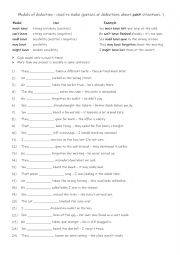
|
5 modals of deduction - used to make guesses or deductions about past situations. 1
Students should learn modals of deduction because they are useful for expressing logical guesses or assumptions about past situations, helping speakers show how certain or uncertain they are. These modals, such as must have, might have, could have , and can�t have, make speech sound more natural and fluent, improve communication and reasoning ski...
Level: elementary
Age: 10-100
Type:
Downloads: 116
|
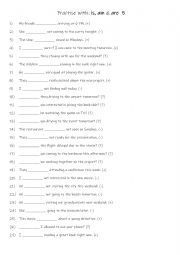
|
A1 Practise with is, am & are 5
Students read the sentence and complete the sentence with the correct form of the verb to be. They use the (+) or (-) sign at the end of the sentence to see if it needs a positive or negative form of the verb to be. Each form is used 3 times! Answers on page 2.
Level: elementary
Age: 8-100
Type:
Downloads: 136
|
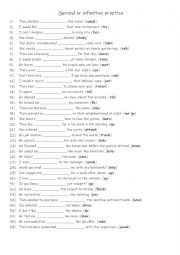
|
B1-B2 Gerund or infinitive practise
Students read the sentences and look at the infinitive in bold to work out if a gerund or infinitive is needed to complete each sentence. Answers on page 2.
Level: intermediate
Age: 10-100
Type:
Downloads: 100
|
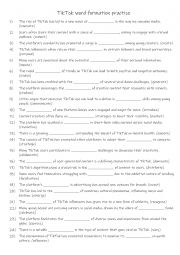
|
B1-B2 TikTok word formation practise
Understanding word formation allows students to expand their vocabulary, enabling them to express themselves more precisely and creatively. Knowing how to manipulate words helps them create varied sentence structures, making their writing more engaging and dynamic. Mastering word formation is key to achieving higher levels of language proficiency, ...
Level: intermediate
Age: 10-100
Type:
Downloads: 114
|
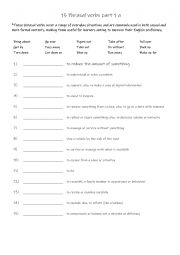
|
15 Phrasal verbs part 1 a
These phrasal verbs cover a range of everyday situations and are commonly used in both casual and more formal contexts, making them useful for learners aiming to improve their English proficiency; they are suitable for CEFR A2-B1 levels. Students match the phrasal verbs to their definitions. Answers on page 2. All of the phrasal verbs used in this ...
Level: elementary
Age: 10-100
Type: worksheet
Downloads: 117
|
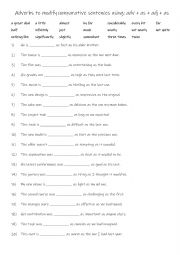
|
B2-C1 20 adverbs to modify comparative sentences using adv + as + adj + as ( Part 1)
Learning adverbs to modify comparative sentences using "adv + as + adj + as" is valuable for enhancing the precision and expressiveness of comparisons. Adverbs like "almost" or "just" allow students to express fine distinctions in comparisons, making their communication more nuanced (e.g., "almost as tall as", "just as fast as"). Adverbs such as "c...
Level: advanced
Age: 10-100
Type:
Downloads: 114
|
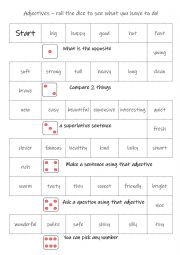
|
A1-A2 40 adjectives � roll the dice to see what you have to do!
Students roll a dice or use a mobile dice app to see what they have to do with the adjective. There are 5 things they need to do; depending on the number shown when the dice is rolled. This makes the worksheet more fun and enables a more productive and engaging speaking activity.
Level: elementary
Age: 8-100
Type:
Downloads: 114
|
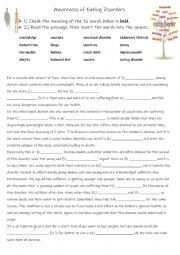
|
Awareness of Eating Disorders
Reading passage with a gap fill exercise about being aware and recognising signs of eating disorders. This sheet is suitable for higher level B1 to B2 students of all ages. An answer sheet is included. For higher level students they could be put in groups to give / present their opinions in a presentation / discussion.
Level: intermediate
Age: 14-100
Type:
Downloads: 1956
|
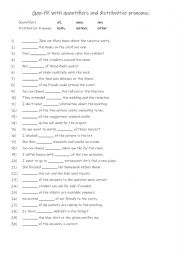
|
A2+-B1 Gap-fill with quantifiers and distributive pronouns
This worksheet gives students this chance to practise using quantifiers and distributive pronouns. In everyday situations, they are used frequently. For example, when shopping, discussing quantities, or distributing tasks, these words help you convey your message more clearly and efficiently.
By learning quantifiers and distributive pronouns, you ...
Level: intermediate
Age: 10-100
Type:
Downloads: 110
|
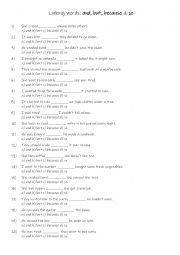
|
A1-A2 Linking words and, but, because & so
Students read the sentences and complete the gap-fill with one of the four multiple choice conjunctions. Answers on page 2.
Level: elementary
Age: 8-100
Type:
Downloads: 103
|












